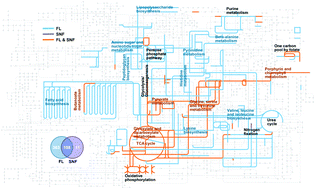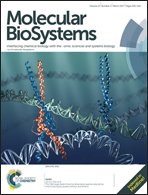Construction and simulation of the Bradyrhizobium diazoefficiens USDA110 metabolic network: a comparison between free-living and symbiotic states†
Abstract
Bradyrhizobium diazoefficiens is a rhizobium able to convert atmospheric nitrogen into ammonium by establishing mutualistic symbiosis with soybean. It has been recognized as an important parent strain for microbial agents and is widely applied in agricultural and environmental fields. In order to study the metabolic properties of symbiotic nitrogen fixation and the differences between a free-living cell and a symbiotic bacteroid, a genome-scale metabolic network of B. diazoefficiens USDA110 was constructed and analyzed. The metabolic network, iYY1101, contains 1031 reactions, 661 metabolites, and 1101 genes in total. Metabolic models reflecting free-living and symbiotic states were determined by defining the corresponding objective functions and substrate input sets, and were further constrained by high-throughput transcriptomic and proteomic data. Constraint-based flux analysis was used to compare the metabolic capacities and the effects on the metabolic targets of genes and reactions between the two physiological states. The results showed that a free-living rhizobium possesses a steady state flux distribution for sustaining a complex supply of biomass precursors while a symbiotic bacteroid maintains a relatively condensed one adapted to nitrogen-fixation. Our metabolic models may serve as a promising platform for better understanding the symbiotic nitrogen fixation of this species.



 Please wait while we load your content...
Please wait while we load your content...